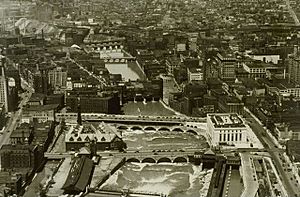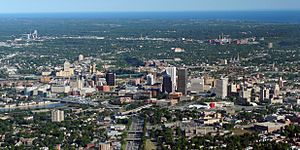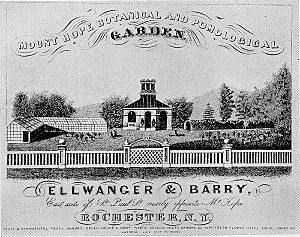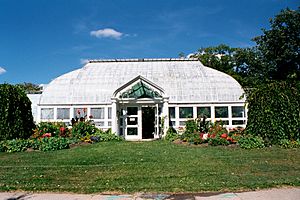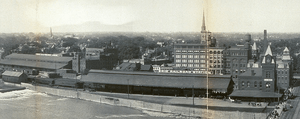History of Rochester, New York facts for kids
This article shares the exciting history of Rochester, New York, a city in western New York State. People started settling here in the late 1700s. The city really grew after the Erie Canal opened. Rochester became a big center for making things. Many people from Italy, Germany, and Ireland moved here, along with a strong group of "Yankees" from New England. These Yankees helped start important movements like ending slavery and fighting for women's rights. Rochester was also famous for being the home of Eastman Kodak, a huge photography company. Even when other industrial cities faced tough times, Rochester kept growing for many years because of companies like Kodak and Xerox.
Did you know that out of 19 places in the United States named Rochester, at least 8 were named after Rochester, New York? This happened because people who used to live here moved and started new towns. Some of these places include Rochester, Indiana; Rochester, Michigan; and Rochester, Minnesota.
Contents
Early Beginnings of Rochester
After the American Revolution, the western part of New York State was ready for new settlements. New York and Massachusetts had argued over who owned this land. In 1786, they made a deal called the Treaty of Hartford. This deal said that New York would govern the land, but Massachusetts had the right to buy it from the Native Americans and then sell it to settlers.
Buying the Land for Settlement
On April 1, 1788, two men from Massachusetts, Oliver Phelps and Nathaniel Gorham, bought the right to purchase about 6 million acres of land in western New York. This land stretched from Lake Ontario south to the Pennsylvania border, all the way to the Niagara River and Lake Erie. This huge area was called the "Phelps and Gorham Purchase". To truly own the land, Phelps and Gorham first had to buy it from the Native Americans.
However, the land didn't sell as well as they hoped. Phelps and Gorham couldn't afford to buy all the land from the Native Americans. So, in 1790, they lost the right to buy the western part of the land. This part, about 3.75 million acres, went back to Massachusetts. Massachusetts then sold these rights to Robert Morris in 1791. Morris later sold most of this land to the Holland Land Company. He also kept a large strip of land for himself, known as the Morris Reserve.
The Mill Yard Tract and First Mills
Before their land deal fell apart, Phelps and Gorham gave a 100-acre piece of land to Ebenezer "Indian" Allen. This land was located near the Genesee River's Upper Falls. The deal was that Allen had to build a grist mill (for grinding grain) and a sawmill there by 1789. This area became known as the "100 Acre Tract". Allen built the mills, but the area was a wild forest with few people. It was also full of rattlesnakes and mosquitoes that carried diseases like malaria.
In 1792, Allen sold the 100-acre tract to Benjamin Barton, who then sold it to Samuel Ogden. Ogden later sold it to Charles Williamson in 1794. Finally, on November 8, 1803, this important 100-acre tract was sold to Col. Nathaniel Rochester (1752–1831) and his partners, Maj. Charles Carroll and Col. William Fitzhugh, all from Maryland.
Rochesterville: The Flour City
Col. Rochester and his partners didn't develop the mill site right away. They waited until 1811 when they finally owned the land completely. At that time, only 15 people lived in the area. They then planned out streets and lots. The first lot was sold to Henry Skinner. In 1817, other landowners joined their lands with the 100-acre tract to create the Village of Rochesterville. It had a population of 700 people.
In 1821, Monroe County was created, and Rochesterville became its main town. A brick courthouse was built. In 1823, more land was added, making Rochesterville about 1,012 acres with a population of 2,500. That same year, the "-ville" was dropped, and the city became simply Rochester.
This was also the year the first 800-foot Erie Canal Aqueduct was finished over the Genesee River. It was built by 30 convicts from Auburn State Prison. In 1822, the Rochester Female Charitable Society was founded. This group helped the poor and later started important places like the Rochester Orphan Asylum (now Hillside Children's Center) and the Rochester City Hospital (now Rochester General Hospital).
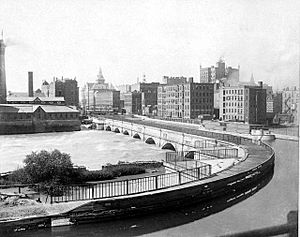
After the Erie Canal opened all the way to the Hudson River in 1825, Rochester's economy and population grew very fast. By 1830, the population reached 9,200. Rochester became known as "The Young Lion of the West." Soon after, it was called the Flour City because of its many flour mills. These mills were located along the Genesee River's waterfalls. In the first ten days the canal was open, 40,000 barrels of Rochester flour were shipped to Albany and New York City.
By 1834, about 20 flour mills were making 500,000 barrels of flour each year. The population reached 13,500, and the city grew to 4,000 acres. Rochester officially became a city, and Jonathan Child, Col. Rochester's son-in-law, was elected its first mayor. By 1838, Rochester was the biggest flour-producing city in the world.
Rochester Becomes The Flower City
In 1830, William A. Reynolds started his first seed business. This led to the famous Ellwanger & Barry Nursery Co., which became one of the largest in the world. Other big nursery businesses like James Vick and Joseph Harris also started in Rochester.
By 1850, Rochester's population reached 36,000. However, farming had moved west to the Great Plains, so Rochester's importance as a flour milling center decreased. But because of its huge seed and nursery companies, Rochester's nickname changed from the Flour City to the Flower City.
In 1850, the University of Rochester was founded. In 1851, a new, larger county courthouse was built because Rochester and Monroe County were growing so much.
Abolitionists and the Civil War Era
Rochester played a very important role in the movement to end slavery. In 1847, Frederick Douglass, a formerly enslaved African who became a powerful leader, started publishing a newspaper called "The North Star" in Rochester. He gave many famous speeches here, including one on July 5, 1852, called "The Meaning of July Fourth to the Negro."
Other important figures like Susan B. Anthony and William Lloyd Garrison also spoke at abolition meetings in Rochester. In the years leading up to the Civil War, many homes in the Rochester area were "safe-houses" for enslaved people escaping to freedom. This network was part of the famous Underground Railroad. Frederick Douglass's home was known to have secret panels and closets to hide people from those who hunted them.
Women's Rights Movement in Rochester
Rochester was a key place for the women's rights movement from very early on. The Rochester Women's Rights Convention of 1848 was held on August 2, 1848. This was only the second such meeting in the entire nation, happening just two weeks after the first one in nearby Seneca Falls. A very important step taken at the Rochester convention was electing a woman as its presiding officer. This was a very bold and controversial move at the time.
Susan B. Anthony, a national leader for women's suffrage (the right for women to vote), was from Rochester. In 1872, she was arrested in Rochester for voting, long before it was legal for women to do so. She was tried in court, and the judge ordered her to pay a fine. Anthony famously said, "I shall never pay a dollar of your unjust penalty," and she never did. While she was often made fun of when she was young, she gained more respect as the country started to take her ideas seriously. She even celebrated her 80th birthday at the White House with President William McKinley. The Nineteenth Amendment to the United States Constitution, which finally gave women the right to vote in 1920, was often called the Susan B. Anthony Amendment because of her lifelong work. Her home in Rochester is now a National Historic Landmark called the National Susan B. Anthony Museum and House.
Industrial Growth After the Civil War
Between 1860 and 1900, Rochester grew a lot, from 48,000 people to 162,800. The city also expanded its area. During this time, many famous companies were founded in Rochester:
- Bausch & Lomb by John Jacob Bausch and Henry Lomb (known for optics and eyewear).
- Eastman Kodak by George Eastman (famous for cameras and film).
- Western Union Telegraph by Hiram Sibley and Don Alonzo Watson.
- Gleason Works by William Gleason (machine tools).
- R.T. French Company by Robert French (mustard and other foods).
Other important industries that grew were clothing and shoe making, brewing, and machine tools. In 1875, Rochester's first city hall opened.
In 1882, the tolls on the Erie Canal ended. In 1885, a group of Rochester businessmen started the Mechanics Institute. This school offered free evening classes in drawing and other subjects important for industrial jobs. Henry Lomb of Bausch & Lomb was its first president.
Many of Rochester's beautiful public parks were created during this time. Ellwanger & Barry and others donated land for Maplewood Park in 1871 and Highland Park in 1889. In 1895, George Eastman and James P. B. Duffy gave even more land for Highland Park.
In 1897, the University of Rochester started giving out master's degrees. In 1900, thanks to Susan B. Anthony's efforts, women were allowed to attend the university. In 1891, the Mechanics Institute joined with the Rochester Athenaeum to form the Rochester Athenaeum and Mechanics Institute (RAMI). This school focused on teaching practical skills for industry.
By the mid-1890s, at least five different railroads served the city, each with its own station. This provided Rochester with excellent transportation. Electric railroads also started serving Rochester in the early 1900s. Rochester was also home to the Cunningham automobile, an early car made by a carriage company.
Rochester in the 20th Century
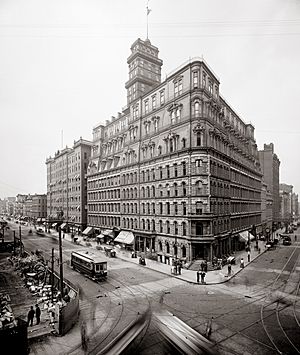
At the start of the 1900s, Rochester was a busy and comfortable city. Some of the old nursery lands were turned into nice neighborhoods. In 1904, R. T. French sent its prepared mustard to the St. Louis World's Fair. There, it became popular when paired with another new food: the hot dog.
In the early 1900s, both George Eastman and Andrew Carnegie gave a lot of money to the University of Rochester. Eastman also funded the Eastman Dental Dispensary. In 1908, more land was donated for Genesee Valley Park and Durand-Eastman Park.
In 1913, the Memorial Art Gallery opened at the University of Rochester. In 1918, the Erie Canal through Rochester was closed. A new canal system, the Barge Canal, opened, passing through Genesee Valley Park. A dam was built in 1918, which changed the Genesee River's flow.
By 1920, Rochester's population reached 290,720. That year, the city bought the old Erie Canal lands within the city to use for a heavy rail system. In 1921, the first Lilac Week celebrated Rochester's beautiful flowers in Highland Park. In 1922, Rochester's first radio station began broadcasting, and the Eastman Theatre opened.
In 1925, George Eastman helped the University of Rochester get new land for its River Campus. The university also opened its Medical School and Strong Memorial Hospital. By 1927, construction on the River Campus began. In 1928, Red Wing Stadium opened for baseball.
By 1930, the population grew to 328,132. The University of Rochester opened its River Campus for men, and the Prince Street Campus became the Women's Campus. The Rochester Municipal Airport also opened. In the 1930s, Eastman Kodak introduced Kodachrome® film. A subway was built in the old canal bed. Rochester celebrated its 100th birthday as a city in 1934.
By 1940, the population had slightly decreased. During World War II, Rochester played a big part in the war effort. Its skilled workers helped produce important goods, and local farms provided food. Some parks, like Cobbs Hill Park, were even used as Prisoner of War camps during the war.
From 1945 to 1999
By 1950, Rochester's population had grown slightly to 332,488. In the 1950s, Xerox Corporation grew a lot, becoming a world leader in copying technology. Eastman Kodak continued to be a major employer. Other big companies included Gleason Works and General Motors. In 1955, the University of Rochester merged its colleges for men and women.
In the 1960s, many people started moving from the city to the suburbs. In 1964, there was civil unrest in Rochester's African-American neighborhoods. This led to changes in city policies and more African-American police officers being hired. Local radio stations also started hiring African-American announcers, like Herb Hamlett, who became a strong voice for Rochester's black community.
Also in the 1960s, the city began urban renewal projects. Midtown Plaza, the first indoor shopping mall in a downtown area in the U.S., was built. The Rochester Institute of Technology (RIT) moved to a new, larger campus in the suburbs in 1968.
In the 1960s and 70s, Rochester became known as a leading jazz city in upstate New York. Famous jazz musicians would play at clubs on Clarissa Street. The Mangione brothers, Chuck and Gap, grew up in Rochester, and Chuck became a very successful jazz trumpeter.
As urban renewal continued, Xerox Corporation opened a tall office tower (Xerox Tower) in 1969. Lincoln Rochester Trust Company (now Chase Bank) also opened a tall office tower. In 1978, city hall moved to a new location.
In the 1990s, a new baseball stadium, Frontier Field, was built for the Rochester Red Wings. Bausch and Lomb built a new headquarters, and a new Central Library expanded the Rochester Public Library.
Rochester in the New Millennium
By the year 2000, Rochester's population was 219,773. In 2003, Rochester built a ferry terminal for the Spirit of Ontario I, a "Fast Ferry" meant to travel across Lake Ontario. However, the ferry project faced many problems and was eventually sold in 2007.
In 2006, a new stadium, now known as Sahlen's Stadium, opened for the Rhinos professional soccer team. The same year, the city's population was estimated to have dropped to 206,000. However, by the 2010 census, Rochester's population had grown back to 210,565, and it has continued to grow slightly each year.
In 2007, PAETEC Holding Corp. announced plans for a new tower downtown. Although the company was later sold, a new, more modest headquarters building for its successor firm, Windstream, was completed in 2013.


